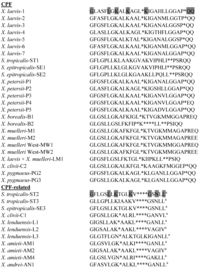

Consistent with previous data, the CPF peptides showed the highest growth inhibitory activity against bacteria with CPF-W6 (GIGSLLAKAAKLAAGLV.NH2) combining high antimicrobial potency against Staphylococcus aureus (MIC=4 μM) with relatively low hemolytic activity (LC50=190 μM).Īllopolyploidy Antimicrobial Caerulein-precursor fragment Frog skin Xenopus.Ĭopyright © 2014 Elsevier Inc. wittei is more closely related to the Xenopus amieti-Xenopus andrei group suggesting a common tetraploid ancestor. vestitus and Xenopus lenduensis, suggestive of bifurcating speciation after allopolyploidization, whereas X. The data support a sister-group relationship between X. The primary structures of the peptides provide insight into phylogenetic relationships among the octoploid Xenopus frogs. The variability in the numbers of paralogs in each peptide family indicates a selective silencing of the host-defense peptide genes following the polyploidization events. wittei secretions contains the novel peptide xenopsin. In addition, secretions from both species contain caerulein, identical to the peptide from Xenopus laevis, but X. Novel Peptide Fragments Originating from PGL and the Caerulein and Xenopsin Precursors from Xenopus he& (Received for publication, September 4,1985) Bradford W. wittei peptides comprise magainin (4 peptides), PGLa (1 peptide), XPF (2 peptides), and CPF (7 peptides). Caerulein activates endogenous gastrin and CCK signaling in vertebrates through CCK1R and CCK2R, suggesting that the preprocaerulein gene functions as a defensive peptide against microbes and predators. vestitus peptides belong to the magainin (3 peptides), peptide glycine-leucine-amide (PGLa 4 peptides), xenopsin-precursor fragment (XPF 1 peptide), and caerulein-precursor fragment (CPF 5 peptides) families. Caerulein is processed from preprocaerulein, which also contains an antimicrobial peptide called the caerulein precursor fragment. Structural characterization demonstrated that the X. Peptidomic analysis was used to compare the diversity of host-defense peptides in norepinephrine-stimulated skin secretions from the octoploid frogs, Xenopus vestitus (Kivu clawed frog) and Xenopus wittei (De Witte's clawed frog) in the family Pipidae. All rights reserved.The primary structures of host-defense peptides have proved useful in elucidating the evolution history of frogs. CPF-AM1 and PGLa-AM1 show promise as templates for the design of novel analogues for the treatment of oral and dental diseases associated with bacteria or fungi.Īntimicrobial peptide Cytokine Host defence peptide Lipopolysaccharide.Ĭopyright © 2014 Elsevier B.V. amieti peptides bound to LPS from three human pathogens and had no effect on oral fibroblast viability. In conclusion, as well as possessing potent antimicrobial actions, the X. Production of the pro-inflammatory cytokine IL-8 by oral fibroblasts was significantly increased following treatment with 1 or 10 μM magainin-AM1 but not following treatment with PGLa-AM1 or CPF-AM1.

Oral fibroblast viability was unaffected by 50 μM peptide treatments.

gingivalis LPS than to LPS from the other species studied. All three peptides showed less binding to P. PGLa-AM1 displayed the greatest propensity to bind lipopolysaccharide (LPS) from Escherichia coli, P. A type strain of Pseudomonas aeruginosa was shown to be more susceptible than the clinical isolate studied. PGLa-AM1 and CPF-AM1 were particularly active against Streptococcus mutans and all three peptides were effective against Fusobacterium nucleatum, whereas Enterococcus faecalis and Candida albicans proved to be relatively resistant micro-organisms. three peptides), caerulein precursor fragment (CPF two peptides). The sequence was composed of 705 bp of coding region, accounting for 234 amino. Antithrombin III (ATIII) is a key antiproteinase involved in blood coagulation. Minimal effective concentrations (MECs), determined by radial diffusion assay, were generally lower than minimal inhibitory concentrations (MICs) determined by microbroth dilution. The complete nucleotide sequence of mRNA for caerulein precursor in the skin of Xenopus laevis was determined. Three peptides, peptide glycine-leucine-amide (PGLa-AM1), caerulein-precursor fragment (CPF-AM1) and magainin-AM1, originally isolated from norepinephrine-stimulated skin secretions of the African volcano frog Xenopus amieti (Pipidae), were studied for their antimicrobial and immunomodulatory activities against oral and respiratory pathogens. Cationic amphipathic α-helical peptides are intensively studied classes of host defence peptides (HDPs).


 0 kommentar(er)
0 kommentar(er)
